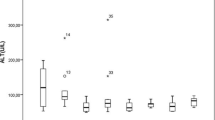Abstract
Reduced gluconeogenesis due to decreased activity of key gluconeogenic enzymes in liver, together with feed refusal, has been suggested to play an important role in 2,3,7,8-tetrachlorodibenzo-p-dioxin (TCDD)-induced lethality in rats. This study was carried out to further analyse the toxicological significance of reduced gluconeogenesis by comparing dose-responses and time-courses of effects of TCDD on the activity of phosphoenolpyruvate carboxykinase (PEPCK) in liver, liver glycogen concentration as well as plasma concentrations of glucose and amino acids in both genders of TCDD-sensitive Long-Evans (L-E) rats and TCDD-resistant Han/Wistar (H/W) rats. A dose-dependent decrease in PEPCK activity was observed in H/W rats, but in L-E rats the activity was not decreased. However, TCDD impaired the strong increase in liver PEPCK activity observed in pair-fed controls of the L-E strain. Liver glycogen concentrations were severely decreased in L-E rats and moderately in H/W rats. This effect seems to be secondary to reduced feed intake, since a similar decrease was seen in pair-fed controls. Decreases in plasma glucose concentrations were also more profound in L-E rats than in H/W rats, but pair-fed controls were generally less affected. Circulating concentrations of amino acids were markedly increased in TCDD-treated L-E rats, which is likely to reflect increased mobilization of amino acids and their decreased metabolism in liver. Reduction of liver PEPCK activity cannot account for the sensitivity difference of these two strains of rats in terms of mortality. Nevertheless, the response of both strains of TCDD-treated rats regarding gluconeogenesis is different from that seen in pair-fed controls and suggesting that impairment of this pathway contributes to the development of the wasting syndrome.
Similar content being viewed by others
Author information
Authors and Affiliations
Additional information
Received: 29 March 1999 / Accepted: 17 May 1999
Rights and permissions
About this article
Cite this article
Viluksela, M., Unkila, M., Pohjanvirta, R. et al. Effects of 2,3,7,8-tetrachlorodibenzo-p-dioxin (TCDD) on liver phosphoenolpyruvate carboxykinase (PEPCK) activity, glucose homeostasis and plasma amino acid concentrations in the most TCDD-susceptible and the most TCDD-resistant rat strains. Arch Toxicol 73, 323–336 (1999). https://doi.org/10.1007/s002040050626
Issue Date:
DOI: https://doi.org/10.1007/s002040050626




